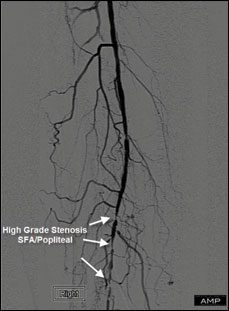Gaining Access: Tips for Transpedal and Tibial Access
Alternative access is becoming part of daily practice in vascular intervention.
Alternative access such as transpedal and tibial access is important in the practice of vascular intervention today. For example, in long chronic total occlusions, the first access we usually try is tibial/pedal access. Our team has found this approach increased our success rate with CTO crossing to more than 90%. How can this be achieved safely?

Tibial/pedal access is gaining popularity merely because our population is changing and living longer. However, this kind of access is not easy to achieve, and it can be difficult to visualize the target vessel during these procedures.
TAMI Revascularization With Ultrasound
Crucial for a successful alternative-access procedure is the right imaging strategy. In patients with peripheral artery disease or critical limb ischemia, there are a variety of body types, heights and anatomies. Obesity presents a major problem. To be successful, you need something that helps you see what you are doing, regardless of how complex a patient’s anatomy might be. I have found this to be instrumental in my CLI approach.

Our group has been successfully performing tibiopedal arterial minimally invasive (TAMI) retrograde revascularization for several years in patients with advanced peripheral vascular disease. In one publication, we compared patients who had the TAMI procedure with patients who had traditional common femoral artery access. In the TAMI case series, there were 23 patients, 82% with Rutherford category 4 to 6, and ultrasound guidance was used to access 100% of the tibial vessels.
We found that the TAMI patients were much sicker patients than those who had traditional common femoral artery access. With that, the steps for a successful TAMI are clearer. The key is use of ultrasound. We found access of the tibial artery so much easier and quicker. Access is routinely achieved in less than 60 seconds.

The TAMI procedure consists of nine steps (see Table). If you follow them carefully, complication rates are very low. In fact, in the aforementioned TAMI case series, where the majority of lesions were CTOs, we were surprised to learn there were no access-site complications, perforations or embolizations. I think the reason complication rates were so low is that we used ultrasound and were extremely cautious.
In another paper, our team analyzed the feasibility and immediate outcomes of ultrasound-guided access in patients with PAD or CLI undergoing peripheral vascular interventions. We found ultrasound-guided access was safe and effective regardless of the arterial bed and approach, success rates and complication rates were comparable to those seen in procedures where conventional retrograde common femoral artery access was used and TAMI procedures utilizing ultrasound-guided access were associated with less contrast use, less fluoroscopy time and shorter length of stay.
Navigating Complex Anatomy

In one case, we were able to treat multiple arteries in a patient who was extremely obese. It was a matter of taking the time and figuring out the best way to navigate the complex anatomy. We treated the superficial femoral artery and the popliteal artery. The SFA was treated retrograde from the anterior tibial artery and then we redirected our equipment from the SFA into the posterior tibial artery. We used two sheaths because we could not initially cross from the anterior tibial artery, so we needed a posterior tibial sheath to help with that.
Keep in mind that all tibial arteries are not crossed the same. The proximal tibial arteries have a different composition than the distal tibial arteries. Try to get access in the distal portion.

New Access Points, New Designs
Alternative access therapy has pushed innovations to deliver effective low-profile devices. The modification of our approach in terms of access has pushed others to develop products that will help our patients. For instance, there are new modalities currently under development, including a stent sized from 2 mm to 8 mm through a 3F sheath. There is also a stent under development that is intended to handle the recoil that we deal with in the tibial arteries. Additionally, a new tibial atherectomy device (FreedomFlow, CardioFlow Inc.), which is 4F compatible, will be useful in treating patients with obesity. It has a rotational design that allows treatment of the arteries up to 8 mm. Potential areas of treatment will also include SFAs and iliac arteries. Of note, today’s lowest profile atherectomy devices include orbital atherectomy (Diamondback 360, Cardiovascular Systems Inc.) and laser atherectomy (Spectranetics/Philips).
Given how our patient population is evolving, a number of different access points are essential in peripheral vascular interventions. Antegrade access holds significant value in CTOs. Combined antegrade/retrograde access may be even more valuable in those cases. A flossing wire has become essential, in my opinion. Among other combinations, radial plus tibial access has been increasing in use. Alternative access is becoming part of our daily practice, and new low-profile devices are allowing additional therapies and increasing the CTO crossing rate.
- References:
- Mustapha JA, et al. Catheter Cardiovasc Interv. 2013;doi:10.1002/ccd25227.
- Mustapha JA, et al. J Invasive Cardiol. 2016;28:259-264.
- For more information:
- J.A. Mustapha, MD, FACC, FSCAI, is co-founder of Advanced Cardiac and Vascular Amputation Prevention Centers in Grand Rapids, Michigan, and clinical associate professor of medicine at Michigan State University College of Osteopathic Medicine. He can be reached at jmustapha@acvcenters.com.
Disclosure: Mustapha reports he is a consultant for Bard Peripheral Vascular, Boston Scientific, Cagent Vascular, Cardiovascular Systems Inc., Cook Medical, Medtronic, Philips, PQ Bypass and Terumo.
